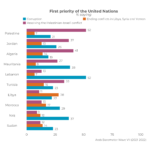Across the Middle East and North Africa, a number of Arab youth are participating in educational programs outside the formal system. As detailed in 2016 surveys conducted by the Arab Barometer, the reasons for participation vary, but are often linked with the goal of increasing job opportunities and the likelihood of employment. However, many citizens perceive such opportunities remain out of reach for them due to cost or other potential barriers. Targeting educational programs outside the formal system to meet the needs of youth across MENA requires understanding how potential participants rate the attractiveness of such programs. In order to examine with better precision how program attributes shape respondents’ motivation to participate in these programs, we designed an original survey experiment that was conducted in Lebanon, Jordan, and the West Bank asking respondents to choose between specific types of programs to determine what makes some more attractive than others. For example, some hypothetical programs focused on computers while others taught languages or the length of classroom time varied between one and five hours per week. Each respondent was presented with a choice between two such programs and asked to select which he or she would prefer…
What Drives Participation in Non-Formal Education in MENA? Evidence from a survey experiment
Download
Conjoint Analysis NFE 

